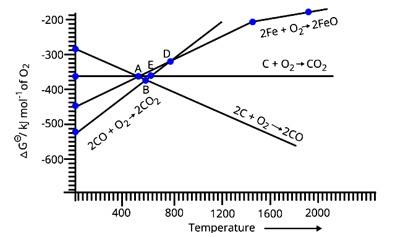Note : Answer the questions 11-13 on the basis of Fig. 6.1.

30. Choose the correct option of temperature at which carbon reduces FeO to iron and produces CO
(i) Below temperature at point A.
(ii) Approximately at the temperature corresponding to point A.
(iii) Above temperature at point A but below the temperature at point D.
(iv) Above temperature at point A.
Note : Answer the questions 11-13 on the basis of Fig. 6.1.

30. Choose the correct option of temperature at which carbon reduces FeO to iron and produces CO
(i) Below temperature at point A.
(ii) Approximately at the temperature corresponding to point A.
(iii) Above temperature at point A but below the temperature at point D.
(iv) Above temperature at point A.
-
1 Answer
-
30. Option (iv)
Above point A, ΔG (C, CO)<ΔG (Fe, FeO). Thus, carbon reduces FeO to iron i.e. Fe and in order carbon is oxidized to carbon monoxide i.e. CO. Both these lines intersect at Point A. As we can see in the figure above point A only carbon could reduce FeO in Fe and CO is being produced.
Similar Questions for you
is the temperature Co-efficient of cell. The cell having less variation of EMF, with respect to temperature have high efficiency.
Below 1350° C, Mg can reduce Al2O3 and above 1350°C, Al can reduce MgO (from Ellingham diagram).
Melting and boiling point of Mg are lower than that of Al.
In ores/mineral available earthy and undesired impurities are gangue
Sol. Reactivity towards depend on stability of carbocation formed
Leaching involves the given reaction,
Here, O2 is required for formation of Au (l) cyanide complex but no complex in absence of O2.
In above displacement reaction, Zn is oxidized.
Taking an Exam? Selecting a College?
Get authentic answers from experts, students and alumni that you won't find anywhere else
Sign Up on ShikshaOn Shiksha, get access to
- 65k Colleges
- 1.2k Exams
- 679k Reviews
- 1800k Answers


